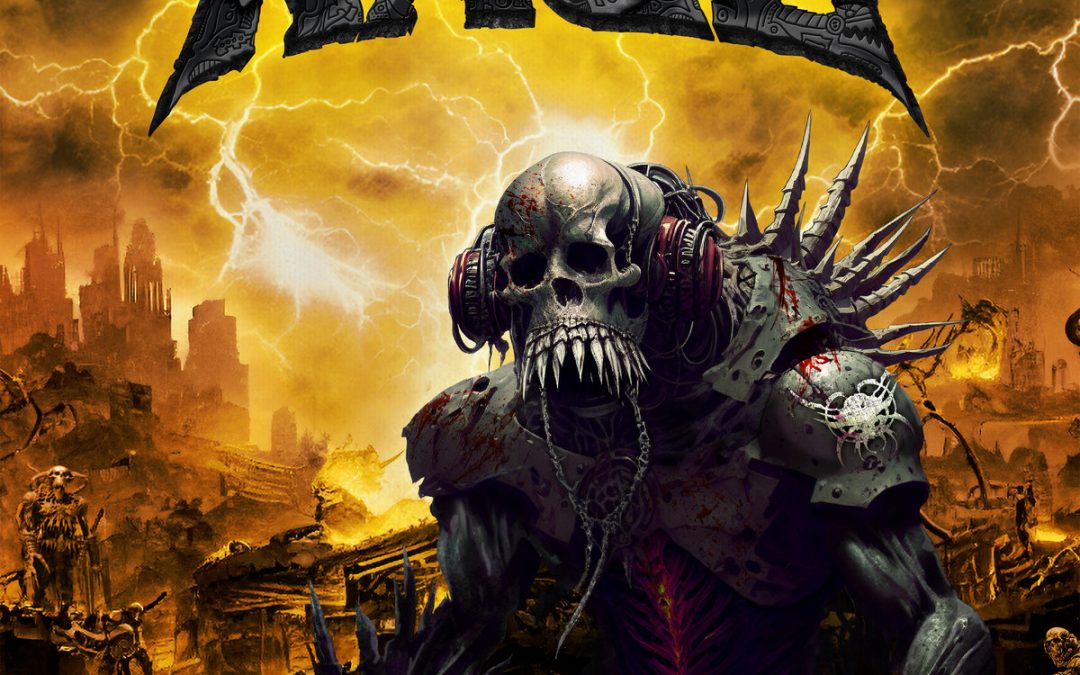Tengo que reconocer que al verme delante del nuevo disco de RAGE me ha invadido una profunda nostalgia, ya que me he visto a mí mismo delante del escaparate de una tienda de discos (ahora es una inmobiliaria), contando las pesetas que llevaba encima para ver si me daba y comprarme el “XIII”. Al final, apenado, me fui sin poder comprármelo. Quién me diría a mí que más de veinticinco años después estaría hablando de su último disco, y que seguiría notando la fuerza y vitalidad en sus temas como si el tiempo no hubiera pasado.
A lo largo de su dilatadísima trayectoria, RAGE ha sufrido múltiples variaciones en su formación, habiendo pasado por ella míticos músicos como Victor Smolski(guitarra) o Mike Terrana (batería). En este momento, la formación ha pasado de ser un trío a un cuarteto, con la incorporación de Stefan Weber, Jean Bormann (ambos a la guitarra) y Vassilios “Lucky” Maniatopoulos como batería. Pero en todo caso, lo que sigue siendo pilar, esencia y fundamento de RAGE es Peavy Wagner.
“Afterlife lines” tiene dos partes diferenciadas: la primera plenamente eléctrica, y una segunda sinfónica, entorno enel que RAGE se mueve como pez en el agua ya que ellos fueron los precursores de fusionar la sonoridad de un grupo de metal con la de una orquesta sinfónica con su “Lingua Mortis” de 1996.
“Afterlife lines”, desde el punto de vista instrumental, sigue dentro de la línea de la excelencia marca RAGE, ya que las sustituciones de los miembros pasados se han hecho con gente muy consolidada. Así, los riffs y solos de los nuevos guitarristas siguen siendo un derroche técnico del más alto nivel. Pero lo que creo que es el elemento fundamental para que este disco sea tan bueno, es la capacidad de Peavy de crear temas muy pegadizos gracias a la fábrica de melodías vocales y rimas que tiene en la cabeza. Temas como “Mortal”, “Toxic waves”, “Under a Black Crown” o “Justicie will be mine” dan buena muestra de ello.
Pasando a la parte sinfónica, creo que no hay mejor forma de resumirla como me decía el propio Juanma en una conversación que tuvimos sobre este disco: “la parte sinfónica está de fondo, es decir, no le dan a lo sinfónico el protagonismo, sino que está acompañando, pero aún así es muy cañera”. El single “Cold desire” o “Root of our devil” te hacen pensar que realmente RAGE está compuesta por toda una orquesta, pues no suena forzado o artificial la inclusión del sonido sinfónico, sino que parece que está en el ADN de la banda.
Creo que me voy a ir a dar una vuelta a una tienda de discos… esta vez pagaré con tarjeta.
![]() [ENGLISH VERSION]
[ENGLISH VERSION] ![]()
I have to admit that when I saw myself in front of the new RAGE album, a deep nostalgia invaded me, because I saw myself in front of the window of a record store (now it’s a real estate agency), counting the pesetas I had on me to see if I could buy «XIII». In the end, saddened, I left without being able to buy it. Who would have thought that more than twenty-five years later I would be talking about his last album, and that I would still feel the strength and vitality in his songs as if time had not passed.
Throughout its long career, RAGE has undergone multiple variations in its line-up, with legendary musicians such as Victor Smolski (guitar) or Mike Terrana (drums) having passed through it. At this moment, the line-up has changed from a trio to a quartet, with the incorporation of Stefan Weber, Jean Bormann (both on guitar) and Vassilios «Lucky» Maniatopoulos on drums. But in any case, what remains the pillar, essence and foundation of RAGE is Peavy Wagner.
«Afterlifelines» has two distinct parts: the first one fully electric, and a second one symphonic, an environment in which RAGE moves like a fish in water since they were the precursors of merging the sonority of a metal band with that of a symphonic orchestra with their 1996 «Lingua Mortis».
«Afterlifelines», from the instrumental point of view, follows within the line of RAGE’s trademark excellence, as the replacements of past members have been made with very consolidated people. Thus, the riffs and solos of the new guitarists are still a technical waste of the highest level. But what I think is the fundamental element that makes this album so good, is Peavy’s ability to create very catchy songs thanks to the factory of vocal melodies and rhymes that he has in his head. Tracks like «Mortal», «Toxicwaves», «Under a Black Crown» or «Justicie will be mine» are good examples of this.
Moving on to the symphonic part, I think there is no better way to summarize it as Juanma told me in a conversation we had about this album: «the symphonic part is in the background, it means, they don’t give the symphonic part the leading role, but it is accompanying, but it is still very powerful». The single «Cold desire» or «Root of our devil» make you think that RAGE is really composed by a whole orchestra, because the inclusion of the symphonic sound doesn’t sound forced or artificial, but it seems to be in the band’s DNA.
I think I’m going to take a trip to a record store… this time I’ll pay by credit card.
Web: https://www.rage-official.com/
YouTube: https://www.youtube.com/@RageOfficial
Facebook: https://www.facebook.com/RageOfficialBand?fref=ts
Instagram: https://www.instagram.com/RageOfficialBand
